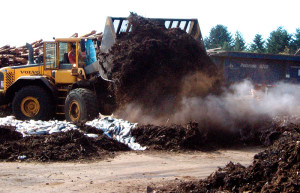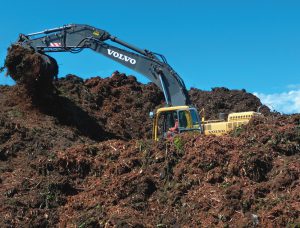North Mason Fiber in Washington State has mastered the art of composting large volumes of fish in aerated static piles.
Dan Emerson
BioCycle September 2013, Vol. 54, No. 9, p. 23
For over 10 years, North Mason Fiber in Belfair, Washington has been turning wood, green waste and other organic material into 18 different products, including compost, bark, mulch and hogged fuel. Bob Dressel started the company in 1989 to recycle wood waste from timber companies in the region into products for the paper industry. He began composting in 2003, and in 2006, ventured into unknown territory when he began accepting fish waste from food processors in the Pacific Northwest and turning it into high-quality compost, selling it under the brand name Oly Mountain Fish Compost.
When Dressel first became interested in making fish compost, one of the motivating factors was the environmental damage — specifically stagnation and oxygen depletion in some bays and harbors in the Puget Sound Basin — being done by the centuries-old practice of “fish dumping,” by fishermen and seafood processors. He estimates that the Oly Mountain operation diverts as much as 55 tons/week of fish waste from landfills. Dressel also knew that the high nitrogen content of fish would translate into high-quality, high-value compost. The fish-based compost has a higher nitrogen content than the company’s green waste compost (around 2% N vs. 1% N respectively), according to Dressel. “It releases that nitrogen slowly, over time — two traits that have made the fish compost a popular product,” he says. “Because of the slow release, you can plant directly into it, with no negative consequences.”

Panoramic view of North Mason Fiber’s fish composting process, including the grinding of wood and green waste, and making a receiving bed for the fish residuals.

Much of the fish arrives whole, coming from offshore and onshore fisheries and hatcheries. A key to composting fish waste is use of a bulking mixture that soaks up the moisture.
The material is composted in positively aerated static piles, typically about 20-feet wide and 75- to 90-feet long. The piles are covered with a biofilter up to 3-feet thick, made of coarse woody debris and finished compost. The material remains under forced aeration for at least 28 days, and sometimes longer, “depending on how things are flowing,” Thomas explains. “The biofilter is a great odor control mechanism, and also shields the piles from the weather.” After being taken off aeration, the compost is cured for about two years.

Wood and green waste is ground using a horizontal Peterson grinder. In addition to the fish waste compost, North Mason Fiber sells a green waste-based compost. Both product lines are certified organic.
Finished compost is screened using a McCloskey trommel. North Mason Fiber is in a unique position as a fish-based compost supplier, Dressel notes. “We’re the only people in the state of Washington permitted to produce bag and bulk fish compost; it’s given us a huge niche market.” The company uses a Rotochopper Go-Bagger to bag the compost. The products (the company also makes a yard trimmings-based compost) are certified organic by the Washington State Department of Agriculture, and are sold under the Oly Mountain label in both bulk and 1 cu. ft. bags wholesale to garden-store retailers and landscapers in the region. The fish compost retails for about $6 to $9/bag.
Dan Emerson is a Contributing Editor to BioCycle.










